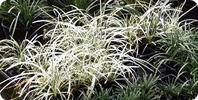Rit Elliott
photo by Rita Elliott
Use and Habitat
Ornamental grasses add a particular charm to gardens, improving informal landscapes and modern layouts alike. Here are a few examples:
To ad and dignity to annual arrangements in containers or flower beds, use such annuals as purple majesty.
Annual grasses fill free space in new plantings:
Perennial grasses form an undulating backdrop for the end-of-season flowering of dwarf aster, fall anemone, sneezeweed, and sedum.
Use grasses to attract birds to your small garden, when there's no room for shrubs.
Ornamental grasses neither lose leaves nor attract bees. Therefore, they are ideal around the swimming pool. A simple layer of mulch can protect the plants from being splashed by chlorinated water.
Add foliage and seed heads from your ornamental grasses to fresh and dried flower bouquets.
Low Maintenance
Cut back annually: In spring, before the new shoots appear, trim stems and leaves to within about 10 cm of the ground for small species and within 20 cm for the largest.
Rely primarily on organic compounds, like compost, to improve the soil. Apply in spring.
After four to five years, your ornamental grasses are ready for dividing. Do this in early spring, while pruning.
Ornamental grasses come in a wide variety of habits: There are dense, carpet-style species, and others that easily grow higher than three metres. Their colouring is as diversified as their shape, ranging from green, bronze, brown and silver, to steel blue and bright red. Maybe you should pay a visit to your garden centre to get a better idea of what is on offer?

